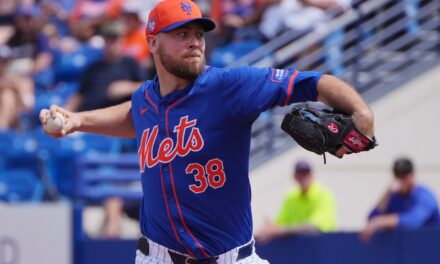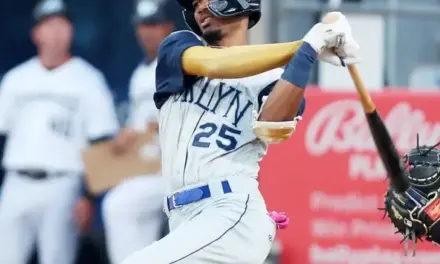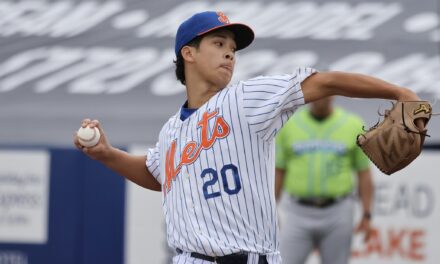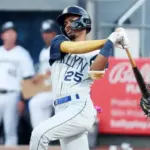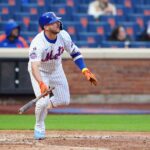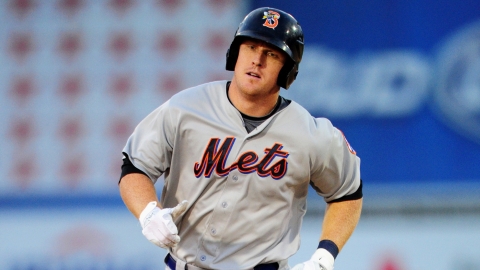
After a season in which Allan Dykstra put together a .274/.436/.503 line with a career-high 21 home runs and 82 RBIs for the Binghamton Mets, the first baseman/designated hitter is eligible to be a minor league free agent this winter. In his third year of Eastern League action since the Mets acquired him from the San Diego Padres in exchange for Eddie Kunz, he earned League MVP honors. However, the former first rounder is now 26-years-old, and it sounds as if some are down on his potential to have any impact in the big leagues.
Except for Sandy Alderson.
Here’s what the Mets GM had to say about Dykstra, reported by Lynn Worthy of the Press & Sun-Bulletin:
He is a little bit older, but he’s a former first-round draft pick. In fact I was in San Diego when he was drafted. A couple of us — Paul DePodesta being the other — were involved in trading for him from San Diego (to bring him) here. He has had a great season, and he has approached the game, offensively, the way the organization hopes to approach the game at the major-league level. I’m hopeful that he can be rewarded for that.
With regard to any potential contributions from the tall left-handed hitter in the big leagues, Alderson still sounds optimistic:
I think that remains to be seen, but I think it’s entirely possible. This is his second year in this league, but only because we were full basically at Las Vegas at his position. So he’s done a great job this year. He’s been a key part of the team, and we still think he’s got a future. Absolutely.
Dykstra has been with the B-Mets for three seasons, but I’m assuming Alderson meant that the first baseman has played two full seasons with Binghamton; his 2012 season was cut short by injury (62 games played in AA). Or, maybe I’m just making an excuse for him.
While it’s possible Alderson was skirting the question and choosing to stay optimistic, what he said is not surprising. Dykstra has built a reputation for drawing a lot of walks and having an insane on-base percentage, which are two things we know the front office cares about.
The first base position at the big league level currently has a lot of uncertainty moving toward 2014; we all know the trials and tribulations between both Ike Davis and Lucas Duda. It remains to be seen what New York’s plan is for the position heading into this winter; if they decide to stick with one of these two internal options, it would be nice to have a potential internal backup plan in case it all goes haywire.
I’m hoping (and anticipating) for Dykstra to remain in the Mets organization beyond this season, and to report to Triple-A Las Vegas at the start of 2014. He’ll essentially act as an insurance policy for the position in the big leagues should something go wrong in Flushing.
Thoughts from Joe D.
When we first acquired Dykstra for Eddie Kunz, I thought very little of the trade. Two first round busts being swapped, big deal. But thanks to the Mets, we are privileged to get access to these players and after watching them play, hearing them talk after a good or bad game, and even speaking to them one on one as I did with Allan last month, a certain bond develops.
I’ve been touting Dykstra all season long on MMO, I didn’t realize until Matt mentioned it that he becomes a minor league free agent now that the season has ended. I do hope we make every attempt to keep him. It has always been my contention that a platoon of Dykstra and Josh Satin at first base would be more productive than any of the seasons we ever got from Keith Hernandez offensively.
Here are some questions and answers from my interview with Allan:
I asked Dykstra, no relation to Lenny by the way, if he knew the Padres were going to select him in the first round in 2008.
“Actually, the Padres were one of the only teams that did not meet with me. Being a San Diego native and growing up in their backyard, they were the team I grew up rooting for. On the day of the draft when I received that call, I was so happy to be drafted by them and knowing I was playing for my hometown team. But obviously I learned quickly that baseball is a business and they traded me to the Mets.”
“That had to be a killer”, I said. “How did you find out… What was going through your head at the time?”
“It was unexpected. We were breaking spring training camp in 2011 on a Sunday, and at about 9:30 in the morning, the Farm Director told me, ‘We traded you. Best of luck. We thought it was a batter fit for the players involved. Tomorrow you’ll be with the Mets”’
“That was it. I was shocked and didn’t know what was happening. I din’t know how to go about it, there’s no instruction guide or handbook for when something like this happens to you. You get plane ticket for a flight in the morning and it’s goodbye and good luck.”
“I don’t mean to laugh,” I told him. “But damn… That sounds so freaking cold.”
He laughed along with me and recalled how little time he had to get to know his new teammates because it was toward the end of spring training for the Mets, and basically he got the tour of the complex and it took a few days to get his bearings straight and learn the lay of the land. “But believe me, it’s a big shock to get traded.”
“There’s a feeling of rejection, but you have to tell yourself that it’s a fresh start and make the best of the situation.”
JD – I know you’ve been blocked at first base at Triple-A, but are you ready for a new challenge?
AD – Definitely. You always want to move up and last year was a disappointment with me getting hurt. I was hoping to start there (Triple-A) this year, but I realize that’s not my decision to make. It’s like you said, there’s just so many players in the organization that all play the same position. That said, it’s something that I can’t let it bother me and I still have a job to do. I love this game, and whether it’s at Las Vegas or Binghamton, I’m still playing baseball and I’m grateful always for that.
JD – Is there a former player you’ve looked up to or even modeled your game after?
AD – When I was younger I was a big Tony Gwynn fan, but as I got older I became a big fan of Chipper Jones. Yes, I know most Met fans probably don’t want to know that, but I initially was a third baseman and a shortstop when I started playing ball and to me Chipper was the best in the game. I also loved Cal Ripken too. Those three players represented the kind of baseball player I wanted to be and were big inspirations. As far as modeling my game, it was Chipper even down to his toe-tap at the plate.
JD – You probably envisioned yourself being in the majors by now?
AD – I envisioned myself there a long time ago, but no seriously, I realize that during my first two pro seasons I didn’t meet a lot of those expectations baseball people had for me. Then I got sidetracked by injuries on top of that, but last year I really started to put up the kind of numbers I knew I was capable of. I continued to work hard and I am proud of the season I’m having now.
JD – Who is the biggest influence for you right now?
AD – Right now and for the last three seasons it’s definitely my hitting coach Luis Natera. He discussed my ups and downs with me when we first met and he really helped me understand things in a way that connected and clicked for me. He’s been a huge influence in my baseball career. I talk to him everyday and not even about baseball stuff, but my personal life too. He’s really been there for me through good times and bad. He’s not only a great coach, but he’s a great person and a great friend.
JD – Do players and coaches normally form this kind of bond at the minor league levels?
AD – I don’t really know, other than my own experience. It’s my third year with Luis Natera and when I first arrived I knew nobody and was looking to make a fresh start and he introduced himself to me and has helped and guided me ever since. He listened to me. When I was down he genuinely listened and cared and said he was going to do whatever he could to help me improve my game and my focus. And that’s exactly what he did.
(photo credit: Gordon Donovan)

